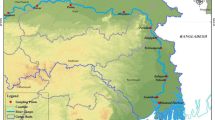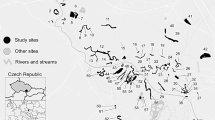Abstract
Knowledge of factors affecting the diversity of benthic invertebrates is very important for biodiversity conservation, for monitoring, restoring and maintaining aquatic ecosystems. The purpose of this study was to investigate how the diversity and distribution of freshwater mollusks related to environmental factors. Twelve species of freshwater mollusks were identified during a survey of 15 thermokarst lakes in the Gydan Peninsula, Russia. Canonical correspondence analysis (CCA) was used to study the relationships between environmental variables and species abundance. The first CCA axis correlated with the content of macro-ions, mainly Mg2+, Na+, Cl−, substrate types, and plant remnants. Along the second CCA axis stations were ordered by depth and the presence of mosses. We found that the type of substrate, depth, abundance of mosses and hydrochemical parameters play an important role in the distribution of the mollusks in thermokarst lakes. These results expand our understanding of mollusks ecology in thermokarst lakes, and identify environmental stressors important for the performance of abiotic control.






Similar content being viewed by others
References
Ashworth, A. C. & R. C. Preece, 2003. The first freshwater molluscs from Antarctica. Journal of Molluscan Studies 69: 89–92.
Anisimov, O.A., D.G. Vaughan, T.V. Callaghan, C. Furgal, H. Marchant, T.D. Prowse, H. Vilhjálmsson & J.E. Walsh, 2007. Polar regions (Arctic and Antarctic). In Parry, M.L. O.F. Canziani, J.P. Palutikof, P.J. van der Linden & C.E. Hanson (eds), Climate Change 2007: Impacts, adaptation and vulnerability. Contribution of Working Group II to the Fourth Assessment Report of the Intergovernmental Panel on Climate Change. Cambridge University Press, Cambridge: 653-685.
Beaty, S. R., K. Fortino & A. E. Hershey, 2006. Distribution and growth of benthic macroinvertebrates among different patch types of the littoral zones of two arctic lakes. Freshwater Biology 51: 2347–2361.
Bespalaya, Y., 2015. Molluscan fauna of an Arctic lake is dominated by a cosmopolitan Pisidium species. Journal of Molluscan Studies 81: 294–298.
Bespalaya, Y., I. Bolotov, O. Aksenova, A. Kondakov, V. Spitsyn, Y. Kogut & S. Sokolova, 2017. Two Pisidium species inhabit freshwater lakes of Novaya Zemlya Archipelago: the first molecular evidence. Polar Biology 40: 2119–2126.
Bespalaya, Y., O. Aksenova & N. Zubriy, 2018. Molluscan fauna of the lower reaches of the Syoyakha River (Yamal Peninsula). Arctic Environmental Research 18: 76–81.
Bespalaya, Y., J. Joyner-Matos, I. Bolotov, O. Aksenova, M. Gofarov, S. Sokolova, A. Shevchenko, O. Travina, N. Zubry, A. Aksenov, A. Kosheleva & D. Ovchinnikov, 2019a. Reproductive ecology of Pisidium casertanum (Poli, 1791) (Bivalvia: Sphaeriidae) in Arctic lakes. Journal of Molluscan Studies 85: 11–23.
Bespalaya, Yu. V., O. V. Aksenova, A. S. Aksenov, S. E. Sokolova, A. R. Shevchenko, O. V. Travina & A. V. Kropotin, 2019b. Reproductive features of Pisidium casertanum (Poli, 1791) (Bivalvia: Sphaeriidae) in relict lakes of Bolshezemelskaya Tundra. Arctic Environmental Research 19: 113–122.
Bogatov, V. V. & L. A. Prozorova, 2017. Taxonomy and diversity of freshwater bivalves (Bivalvia) of China (on the basis of analysis catalog Heat Zhuang 2013). Zoologicheskii Zhurnal 96(2): 153–171. [in Russian].
Bódis, E., J. Nosek, N. Oertel, B. Tóth, E. Hornung & R. Sousa, 2011. Spatial distribution of bivalves in relation to environmental conditions (middle Danube catchment, Hungary). Community Ecology 12: 210–219.
Bößneck, U., C. Clewing & C. Albrecht, 2016. Exploring high-mountain limnic faunas: discovery of a novel endemic bivalve species (Sphaeriidae: Pisidium) in the Nepal Himalayas. Invertebrate Systematics 30: 588–597.
Burmakin, E., 1936. Food resources Gydanskogo Bay and the nearby water bodies. Trudi Nauchno-Issledovatelskogo Instituta Polyarnogo Zemledeliya Zhivotnovodstva I Promislovogo Khozyaistva. Series Promislovoe Khozyaustvo 15: 159–177. [in Russian].
Clewing, C., U. Bössneck, P. V. Oheimb & C. Albrecht, 2013. Molecular phylogeny and biogeography of a high mountain bivalve fauna: the Sphaeriidae of the Tibetan Plateau. Malacologia 56: 231–252.
Coulson, S. J. & N. G. Midgley, 2012. The role of glacier mice in the invertebrate colonisation of glacial surfaces: the moss balls of the Falljökull, Iceland. Polar Biology 35: 1651.
Dillon, R. T., 2000. The ecology of freshwater molluscs. Cambridge University Press, Cambridge.
Dolgin, V. N., 2002. The latitudinal-zonal distribution of freshwater mollusks and ecological-biogeographical zonation of Northern Siberia, Vestnik Tomskogo pedagogicheskogo universiteta. Estestvennie i Tochnie Nauki 2(30): 40–46. [in Russian].
Dolgin, V. & B. Johansen, 1973. Freshwater mollusks of the Gydan Peninsula. Biological Sciences 9: 16–19. [in Russian].
Dolgin, V. N., 2001. Freshwater mollusks of the subarctic and arctic regions of Siberia: DSc (biology) dissertation. Tomsk, 2001. [in Russian]
Drozdov, V. N., 1967. Notes about the fauna of molluscs of the Ob Polar Region. Voprosi gigieni. Omsk, 42–45. [in Russian]
Gargomini, O., V. Prie, J.-M. Bichain, X. Cucherat & B. Fontaine, 2011. Liste de référence annotée des mollusques continentaux de France. MalaCo 11: 307–382.
Guralnick, R. P., 2005. Combined molecular and morphological approaches to documenting regional biodiversity and ecological patterns in problematic taxa: a case study in the bivalve group Cyclocalyx (Sphaeriidae, Bivalvia) from western North America. Zoologica Scripta 3: 469–482.
Glöer, P. & C. Meier-Brook, 2003. Süsswassermollusken. Ein Bestimmungschlüssel für die Bundesrepublik Deutschland. 13 Auflage. Deutscher Jugendbund für Naturbeobachtun, Hamburg
Graf, D. L., 2013. Patterns of freshwater bivalve global diversity and the state of phylogenetic studies on the Unionoidae, Sphaeriidae, and Cyrenidae. American Malacological Bulletin 31: 135–153.
Gudovskikh, Yu V, T. L. Egoshina & L. S. Savintseva, 2016. The study of biota of the proposed protected area « Yuribeyskiy » (Gydanskiy Peninsula) Vestnik Udmurtskogo Universiteta. Biologiya Nauki o Zemle 26(1): 15–28. [in Russian].
Hall, T. A., 1999. BioEdit: a user-friendly biological sequence alignment editor and analysis program for Windows 95/98/NT. Nucleic Acids Symp Ser 41: 95–98.
Hammer, O., D.A.T. Harper & P.D. Ryan, 2001. PAST: paleontological statistics software package for education and data analysis. Palaeontologia Electronica, 4: art. 4.
Heino, J., 2000. Lentic macroinvertebrate assemblage structure along gradients in spatial heterogeneity, habitat size and water chemistry. Hydrobiologia 418: 229–242.
Heino, J., 2005. Functional biodiversity of macroinvertebrate assemblages along major ecological gradients of boreal headwater streams. Freshwater Biology 50: 1578–1587.
Horsák, M. & M. Hájek, 2003. Composition and species richness of mollusc communities in relation to vegetation and water chemistry in the Western Carpathian spring fens: the poor-rich gradient. Journal of Molluscan Studies 69: 349–357.
Kalyakin, V. N., F. A. Romanenko, A. V. Molochaev, E. V. Rogacheva & E. E. Syroechkovsky, 2000. Gydansky Nature Reserve. Reserves of Russia. Nature Reserves of Siberia. II. Logata, Moscow.
Kling, G. W., 2009. Lakes of the Arctic. In Likens, G. E. (ed.), Encyclopedia of Inland Waters. Elsevier, Oxford: 577–588.
Korniushin, A. V., 1996. Bivalve molluscs of the superfamily Pisidioideain the Palaearctic region: fauna, systematics, phylogeny. Schmalhausen Institute of Zoology, Kiev. [in Russian].
Korniushin, A. V., 2001. Taxonomic revision of the genus Sphaerium sensu lato (Bivalvia Sphaeriidae) in the Palaearctic Region, with some notes on the North American species. Arch Molluskenkd 129: 77–122.
Lee, T. & D. Ó. Foighil, 2003. Phylogenetic structure of the Sphaeriinae, a global clade of freshwater bivalve molluscs, inferred from nuclear (ITS-1) and mitochondrial (16S) ribosomal gene sequences. Zoological Journal of the Linnean Society 137: 245–260.
Lorencová, E. & M. Horsák, 2019. Environmental drivers of mollusc assemblage diversity in a system of lowland lentic habitats. Hydrobiologia. https://doi.org/10.1007/s10750-019-3940-9.
Moore, J. S., 1978. Some factors influencing the diversity and species composition of benthic invertebrate communities in twenty Arctic and Subarctic Lakes. International Review of Hydrobiology 63: 757–771.
Palumbi, S. R., 1996. Nucleic acids II: the polymerase chain reaction. In Hillis, D. M., C. Moritz & B. K. Mable (eds), Molecular systematics. Sinauer Associates, Inc., Sunderland, MA: 205–247.
Popov, P. A., 2011. Characteristics of ichthyofauna reservoirs of the Gdansky Peninsula. Vestnik Tomskogo gosudarstvennogo universiteta. Biology 3: 127–138.
Raddum, G. G. & A. Fjellheim, 2002. Species composition of freshwater invertebrates in relation to chemical and physical factors in high mountains in southwestern Norway. Water Air and Soil Pollution. Focus 2: 311–328.
Sambrook, J., E. F. Fritsch & T. Maniatis, 1989. Molecular Cloning: A Laboratory Manual, 2nd ed. Cold Spring Harbor Laboratory Press, New York.
Samchyshyna, L., L. A. Hansson & K. Christoffersen, 2008. Patterns in the distribution of Arctic freshwater zooplankton related to glaciation history. Polar Biology 31: 1427–1435.
Sisko, R. K., 1977. Yamalo-Gydanskaya oblast (physiographic characteristics). Gidrometeoizdat, Leningrad. [in Russian].
Sousa, R., P. Morais, C. Antunes & L. Guilhermino, 2008. Factors affecting Pisidium amnicum (Müller, 1774; Bivalvia: Sphaeriidae) distribution in the River Minho Estuary: consequences for its conservation. Estuaries and Coasts 31: 1198–1207.
Sousa, R., M. Ilarri, A. T. Souza, C. Antunes & L. Guilhermino, 2011. Rapid decline of the greater European peaclam at the periphery of its distribution. International Journal of Limnology 47: 211–219.
Stolbov, V. A., O. A. Aleshina, A. A. Prokin & D. A. Allayarov, 2017. The study of the hydrochemical composition, zooplankton and macrozoobenthos of some floodplain lakes of the typical tundra of the Gydan Peninsula. Water: Chemistry and Ecology 8: 11–18. [in Russian].
ter Braak, C.J.F.& P. Šmilauer, 2002. CANOCO reference manual and CanoDraw for Windows user’s guide: software for canonical community ordination (version 4.5). Microcomputer Power, Ithaca, NY.
Vincent, W. F. & J. Laybourn-Parry, 2008. Polar Lakes and Rivers: Limnology of Arctic and Antarctic Aquatic Ecosystems. Oxford University Press, Oxford.
Vuori, K. M., H. Luotonen & P. Liljaniemi, 1999. Benthic macroinvertebrates and aquatic mosses in pristine streams of the Tolvajärvi region, Russian Karelia. Boreal Environment Research 4: 187–200.
Wrona, F. J., T. D. Prowse, J. Reist, R. Beamish, J. J. Gibson, J. Hobbie, E. Jeppesen, J. King, G. Koeck, A. Korhola, L. Lévesque, R. Macdonald, M. Power, V. Skvortsov & W. Vincent, 2005. Freshwater ecosystems and fisheries. In Symon, C., L. Arris & B. Heal (eds), Arctic Climate Impact Assessment, ACIA. Cambridge University Press, New York: 353–452.
Wrona, F. J., J. D. Reist, P.-A. Amundsen, P. A. Chambers, K. Christoffersen, J. M. Culp, P. D. di Cenzo, L. Forsström, J. Hammar, R. K. Heikkinen, J. Heino, K. K. Kahilainen, H. Lehtonen, J. Lento, L. Lesack, M. Luoto, D. J. Marcogliese, P. Marsh, P. A. Moquin, T. Mustonen, M. Power, T. D. Prowse, M. Rautio, H. K. Swanson, M. Thompson, H. Toivonen, V. Vasiliev, R. Virkkala & S. Zavalko, 2013. Freshwater ecosystems. Chapter 13. In Meltofte, H. (ed.), Arctic Biodiversity Assessment: Status and trends in Arctic biodiversity. Narayana Press, Akureyri: 443–485.
Acknowledgements
The authors express their gratitude to two anonymous reviewers, whose detailed consideration of the manuscript has significantly improved the work. The Ministry of Science and Higher Education of the Russian Federation supported the study of biodiversity of freshwater bivalves (Project No. AAAA-A17-117033010132-2), the study of environmental parameters was supported by the program of Presidium Ural Branch of RAS (No. AAAA-A17-117122890059-1), Russian Science Foundation supported the molecular analyses of mollusks (No. 19-14-00066). The Russian Foundation for Basic Research supported the study of the distribution of freshwater mollusks depending on environmental factors (No. 20-04-00361) and the study of biodiversity of freshwater gastropods (No. 17-44-290016 r_a).
Author information
Authors and Affiliations
Corresponding author
Additional information
Publisher's Note
Springer Nature remains neutral with regard to jurisdictional claims in published maps and institutional affiliations.
Guest editors: Manuel P. M. Lopes-Lima, Nicoletta Riccardi, Maria Urbanska & Ronaldo G. Sousa / Biology and Conservation of Freshwater Molluscs
Electronic supplementary material
Below is the link to the electronic supplementary material.
Rights and permissions
About this article
Cite this article
Bespalaya, Y.V., Aksenova, O.V., Sokolova, S.E. et al. Biodiversity and distributions of freshwater mollusks in relation to chemical and physical factors in the thermokarst lakes of the Gydan Peninsula, Russia. Hydrobiologia 848, 3031–3044 (2021). https://doi.org/10.1007/s10750-020-04227-9
Received:
Revised:
Accepted:
Published:
Issue Date:
DOI: https://doi.org/10.1007/s10750-020-04227-9




